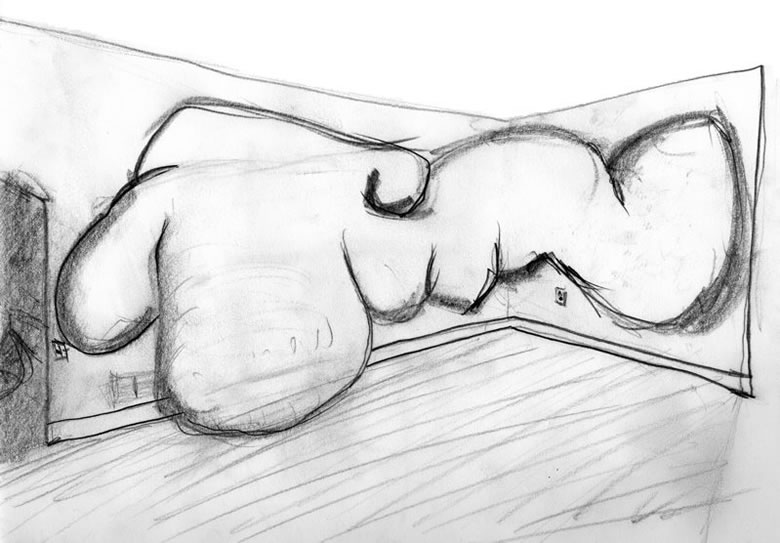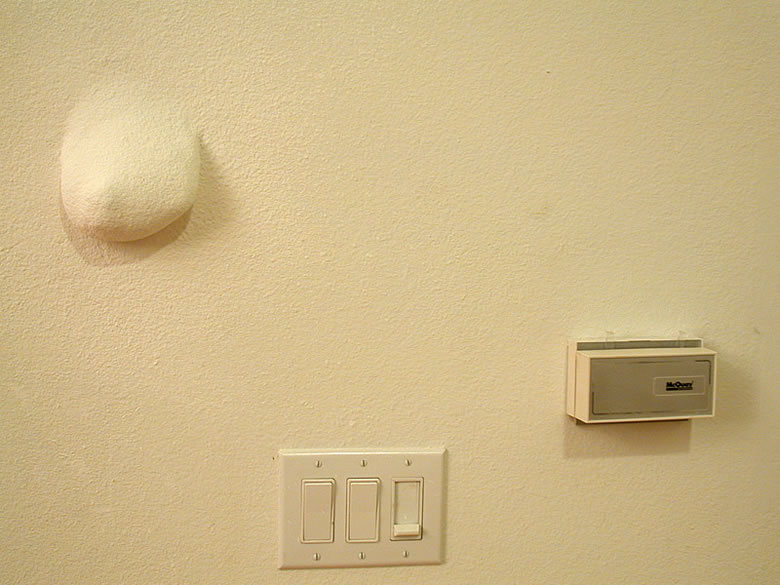Fill a Small Room

Study for small space | graphite on paper | 2004
Here’s an old drawing I did when I was in the UTD residency. We were given these gallery spaces at the front of the apt. to use either as a studio or clean space to show our work. The idea with this piece was to fill a small space with very large blob-like forms coming out of the walls. For the most part it was site specific. This way of working is starting to make more sense to me again. I’ve been thinking a lot about how I want to realize certain works in actual spaces (other than a gallery).
Below is a small version I did in the apt. during the residency. Everyone who saw it likened it to a boob so it became a wall boob. Of course that was the last thing on my mind. It was a form I was able to create quickly so as to test out if the mold making material (tin cure rubber I think) would set on wet clay. What really stuck for me about this study was how it was located next to the normal, mundane items that one usually finds in a home. Did one activate the other, or did the wall boob become just as ordinary as the light switch and the thermostat? Or something else all together?

Study | urethane foam, wall paint, acoustic texture | 2005
Which of these is not like the other? The wall boob seems to be an outgrowth of the wall as opposed to an object applied to it, even though that is what it acually is. Something I think would have been called a bleb when I was in Biology class. The wall reacting to it’s environment. To feed, feel or avoid.
I think you get the gist. They are the same in my mind but I agree that the drawing lacks the effects that show in the image.
Ryan,
I wasn’t very clear in my previous post. My comments were concerning the wall boob alone.
The wall boob doesn’t strike me as normal, mundane or ordinary. The only relationships I can see between it and the other two objects are proximity, value and scale. But in every other way the wall boob is the opposite of the others. They are mechanical, geometric and functional, the boob is architectural in position (in that it seems an outgrowth of the wall) but is biomorphic and functionless (except perhaps as an odd decoration). The next step which your study sketch took was to invent a negative function. The outgrowth you drew would project off the wall (in fact seems to link two walls) and begin to fill the surrounding inhabitable space, undermining the wall’s function of defining the room’s space. If large enough, the room itself would be negated as a useful space. The shapes that you use seem appropriate for this as they suggest tumorous outgrowths. This in my mind makes these pieces anything but normal or mundane. They seem subtly but definately aggressive.
In these pieces and ideas (including the teapots, I think), form does’nt follow function but rather form obstructs or negates function. Are you a Dadaist?
now that i like- it is like an intended mistake.